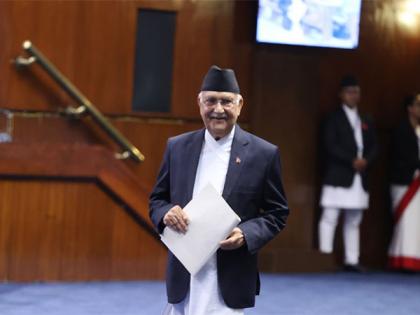Nepal cabinet declares Madhesh province disaster crisis zone as absence of rain invites crisis in nation's breadbasket
By ANI | Updated: July 23, 2025 23:09 IST2025-07-23T23:01:25+5:302025-07-23T23:09:27+5:30
Kathmandu [Nepal], July 23 : An emergency cabinet meeting held on Wednesday has declared Nepal's Madhesh province a disaster ...

Nepal cabinet declares Madhesh province disaster crisis zone as absence of rain invites crisis in nation's breadbasket
Kathmandu [Nepal], July 23 : An emergency cabinet meeting held on Wednesday has declared Nepal's Madhesh province a disaster crisis zone as severe drought hit the nation's breadbasket. The unusual absence of rain in the southern plains of Nepal during the mid-monsoon has pushed the region into a state of crisis.
Nepali Prime Minister KP Sharma Oli on Wednesday informed the parliament that the cabinet had made a decision based on the situation in the southern plains.
"A cabinet meeting today declared the Madhesh Province a disaster crisis zone. It means the budget which are required at the time of disaster can also be used urgently," Oli said.
The decision was made based on a proposal by the Ministry of Home Affairs. The severe drought has affected all eight districts along the Terai belt of the Himalayan nation, which hosts the most fertile and arable landmass.
"The groundwater level is receding, resulting in the hand-pumps and wells running dry. There is a scarcity of drinking water; there is no water for cleaning purposes as well. Concerned with the situation there, the government, after holding discussions at various levels, has deployed different teams to resolve the situation out there," Oli claimed.
The government made the declaration under Section 32, Subsection 1, of the Disaster Risk Reduction and Management Act of 2017.
The law allows the government to declare any area a disaster-threatening zone by publishing a notice in the Nepal Gazette, specifying its boundaries and the duration of
The declaration, if deemed necessary and expedient due to the occurrence of a severe disaster.
A prolonged dry spell during the peak monsoon season has brought much of Nepal's Tarai region to the brink of an agricultural crisis.
Due to acute water shortages, farmers are unable to transplant paddy. The drought has left seedbeds dry, and paddy saplings are withering, sparking fears of an impending food shortage in Nepal's major rice-producing region.
Also, the provincial government of Madhesh a few days ago declared the province a drought-hit zone. The provincial administration utilised fire trucks and tankers to distribute drinking water, but these efforts fell short of meeting the agricultural needs. The scarcity of water during mid-monsoon in the Tarai, Nepal's food basket, threatens not only farmers' livelihoods but also the national economy.
Madhesh province, which is the breadbasket of the Himalayan Nation, still relies on rainwater for cultivation. Central bank- The Nepal Rastra Bank's 2024 report on 'Economic Status of Madhesh Province' had shown that an increase in the province's gross domestic product will be due to an increase in its agricultural production. NRB had projected Madhesh Province's Gross Domestic Product (GDP) to stand at Nepali Rupees (NRs) 707 billion.
Madhesh's GDP accounted for 13.13 per cent of the country's GDP, out of NRs 5.381 trillion. In Madhesh Province, farm products account for 35.2 per cent of the gross domestic product.
Food crops, vegetables, fruits and spices are among the main products of this province.
However, the dry and arid monsoon this year has increased worries for the farmers, who are now starting to worry about their coming days.
Since the start of the monsoon this year, around two dozen people have already lost their lives to landslides and flooding. Several others have been injured and are missing in monsoon-related disasters. Properties and infrastructure worth billions of rupees have been either washed away by floods or buried in landslides.
Locals in the mountainous region say that the weather has become so erratic that even light rainfall triggers floods. Scores of glacial and supraglacial lakes could burst at any time due to the melting of ice accelerated by global warming. At least eleven people were killed, and 17 others are still missing, in the Bhotekoshi flood triggered by a previously unnoticed supraglacial lake formed in Tibet above Rasuwagadhi.
Nepal has been experiencing changes in temperature and precipitation at a rate faster than the global average, according to studies. Evidence indicates that the maximum temperature in Nepal is rising at a greater rate (0.05 degrees Celsius per year) than the minimum temperature (0.03 degrees Celsius per year).
The prevailing situation in Madhesh Province comes amid the prediction by the Met's office of above-normal monsoon rainfall this year. Nepal, on an annual basis, faces disasters such as floods, landslides, and inundation, resulting in loss of life and property.
A continuous downpour over three days last year resulted in widespread damage to properties, as well as the loss of approximately 200 lives due to the monsoon-induced disaster.
As the Himalayan Nation is bracing for above-average rainfall this year, the National Disaster Risk Reduction and Management Authority (NDRRMA) has predicted that around two million (19,97,731) people from 4,57,145 households could be affected by monsoon-related disasters.
According to the projection, the districts of Lumbini province will be affected the most in the monsoon5,23,656 people from 1,19,830 households will be affected. This is
followed by the Bagmati3,27, 376 people from 74,914 households, Gandaki2,87,107 people from 65,699 households, Koshi 2,75,867 people from 63,127 households, Madhesh228,687 people from 52,331 households, Sudurpaschim2,27,730 people from 52,112 households, and Karnali province127,308 people from 29,132 households.
Disclaimer: This post has been auto-published from an agency feed without any modifications to the text and has not been reviewed by an editor
Open in app